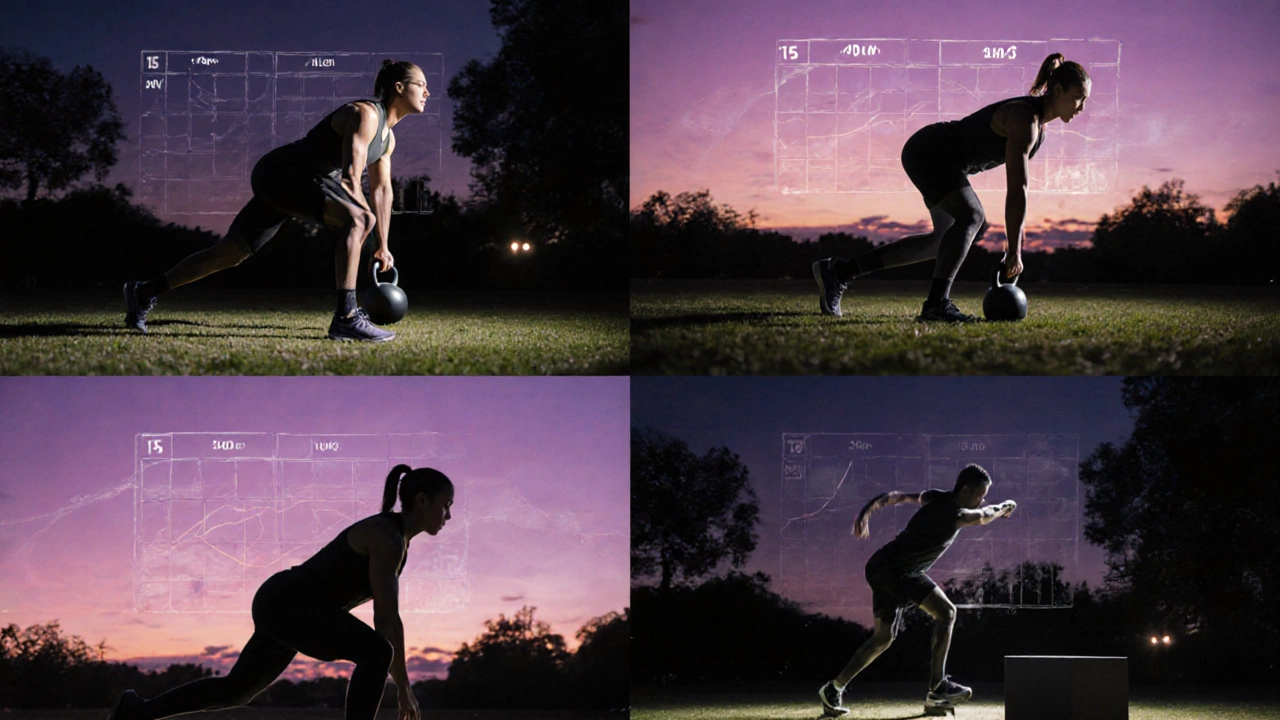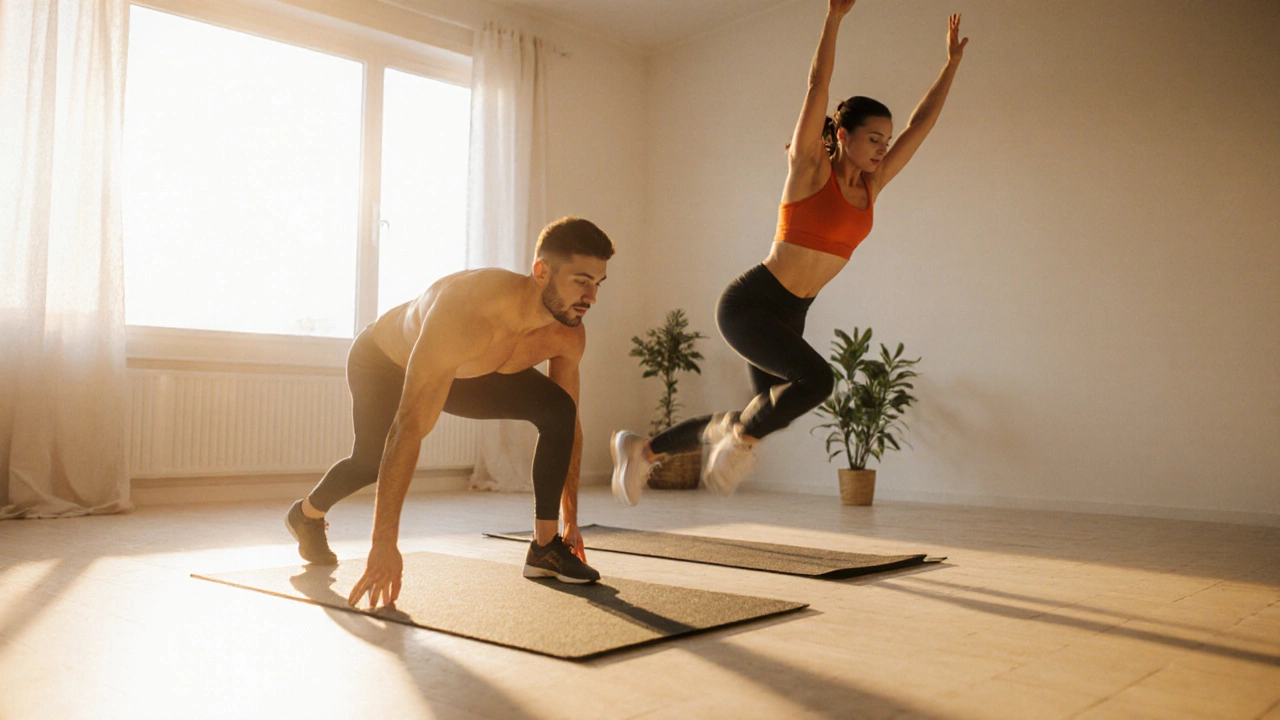Burpee Fitness Calculator
Calculate Your Burpee Impact
Estimate the calorie burn and fitness benefits of your burpee routine.
Your Burpee Workout Results
Fitness Progression Tips
- Start with 5-10 burpees per set, 2-3 sets
- Increase intensity gradually to avoid overexertion
- Try variations like half burpees or weighted burpees for advanced training
- Combine burpees with other exercises for a full-body routine
Ever wonder which move can give you strength, cardio, and flexibility all at once? The answer is simple: the best exercise you can do anywhere, with no gear, is the burpee. Below we break down why the burpee tops the list, how to master it, and how it stacks up against other power moves.
Why a Single Exercise Can Dominate
Fitness experts often chase trends-HIIT, kettlebell swings, CrossFit WODs-but the most enduring metric is how many muscle groups an action engages, how much calorie burn it generates, and how easily it fits into daily life. An exercise that checks all three boxes becomes a universal winner.
The #1 Exercise: Burpee
Burpee is a full‑body, plyometric movement that combines a squat, jump, and plank‑position push‑up in one fluid sequence. First popularized in the 1930s by Royal H.Burpee, the drill was meant to assess fitness quickly; today it’s a staple in boot camps, military training, and home workouts.
Key attributes of the burpee:
- Primary muscles: quadriceps, glutes, pectorals, deltoids, core
- Equipment: none (optional mat for comfort)
- Intensity: high - raises heart rate within seconds
- Calorie burn: approx. 10‑12kcal per minute for a 70kg adult doing continuous reps
- Skill level: beginner to advanced (modifiable)
How to Do a Perfect Burpee (Step‑by‑Step)
- Stand tall with feet shoulder‑width apart.
- Drop into a squat, place your hands on the floor just in front of you.
- Kick your feet back, landing in a plank position. Push‑up optional, adds upper‑body load if you want extra challenge.
- Immediately pull your feet forward back to the squat.
- Explode upward, jumping off the ground with arms reaching overhead.
- Land softly and reset for the next rep.
Focus on smooth transitions; rushing the move can compromise form and increase injury risk.
Benefits That Make It #1
Because the burpee hits every major muscle group, it delivers a cascade of benefits:
- Cardiovascular boost: The rapid shift from squat to jump spikes heart rate, mimicking interval training.
- Strength development: Squat and push‑up components load the legs and upper body simultaneously.
- Core stability: Maintaining a straight plank during the kick‑back phase engages the abdominals and lower back.
- Metabolic fire: High‑intensity bursts raise post‑exercise oxygen consumption, burning calories long after you finish.
- Convenience: No gym, no equipment-just a bit of floor space.
Research from the Journal of Strength & Conditioning (2023) shows a 30‑minute burpee circuit can equal the calorie burn of a 45‑minute moderate jog.
Variations for Different Levels
If a full burpee feels too intense, try these tweaks:
- Half burpee: Skip the push‑up and the jump; just stand up from the squat.
- Burpee with knee‑push‑up: Lower onto knees instead of full push‑up for reduced upper‑body load.
- Weighted burpee: Hold a dumbbell or kettlebell during the squat for added resistance.
- Box jump burpee: Replace the overhead jump with a step‑up onto a sturdy box to protect knees.
These options let beginners build confidence while still reaping the core benefits.
Comparing the Burpee to Other Power Moves
Below is a quick side‑by‑side look at the burpee, squat, and deadlift-three exercises often touted as fitness pillars.
| Attribute | Burpee | Squat | Deadlift |
|---|---|---|---|
| Primary Muscles | Quads, glutes, chest, shoulders, core | Quads, glutes, hamstrings | Hamstrings, glutes, lower back, traps |
| Equipment Needed | None | None (optional barbell) | Barbell & plates |
| Intensity Level | High | Moderate | Variable (depends on load) |
| Calorie Burn (per min, 70kg) | 10‑12kcal | 5‑6kcal (steady reps) | 6‑8kcal (heavy sets) |
| Skill Requirement | Beginner‑to‑advanced | Beginner‑to‑advanced | Intermediate‑to‑advanced (form critical) |
While squats and deadlifts are fantastic for building strength, only the burpee fuses cardio, strength, and mobility in a single rep-making it the most versatile single movement.

When the Burpee Might Not Be Ideal
Even the #1 exercise has limits. Consider these scenarios:
- Joint issues (knees, wrists, shoulders): The high‑impact jump can stress vulnerable joints.
- Early pregnancy: Impact and core loading may be unsafe.
- Severe cardiovascular conditions: The rapid heart‑rate spikes could be risky without medical clearance.
In such cases, swap the jump for a step‑back or replace the push‑up with a plank hold, and still gain many of the benefits.
Building a Burpee‑Centric Routine
Here’s a simple three‑day template that slots burpees into a balanced program:
- Day1 - HIIT Burst: 5×30‑second burpee sprints, 30‑second rest; finish with 2×30‑second plank holds.
- Day2 - Strength Mix: 3×10burpees + 12squat jumps; superset with 3×8Pull‑up or assisted pull‑up.
- Day3 - Active Recovery: Light Jumping Jacks for 5 minutes, followed by 4×30‑second burpee holds (hold the squat position, no jump) to keep muscles engaged.
Adjust volume based on fitness level-start with 5‑10 total reps per session and build up.
Key Takeaways
- The burpee is the only exercise that simultaneously trains strength, cardio, and core.
- It needs zero equipment, making it perfect for home, park, or travel.
- Variations let you scale the movement from beginner to elite.
- Use it in HIIT circuits, strength supersets, or as a conditioning finisher.
Frequently Asked Questions
How many burpees should I do in a workout?
Beginners can start with 5‑10 reps per set, aiming for 2‑3 sets. More advanced athletes often perform 20‑30‑second sprint intervals, totaling 100‑150 reps in a 20‑minute HIIT session.
Can I lose belly fat with burpees alone?
Burpees boost overall calorie burn and improve metabolic rate, which helps reduce body‑fat when paired with a balanced diet. Spot‑reduction isn’t realistic, but regular burpee sessions accelerate total‑body fat loss.
Are burpees safe for older adults?
Yes, with modifications. Remove the jump and replace the full push‑up with a knee‑push‑up or a simple plank hold. Focus on low‑impact squat‑to‑stand movements to protect joints.
How do burpees compare to running for cardio?
A 10‑minute burpee sprint can burn roughly the same calories as a 20‑minute moderate jog, while also building strength. For pure endurance, running remains superior, but burpees give a dual benefit in less time.
What’s the best time of day to do burpees?
Any time works, but mornings can boost metabolism for the day, while evening sessions can serve as a strong stress‑relief finisher. Choose when you feel most energized.
